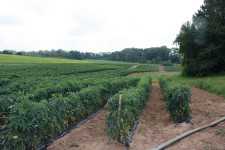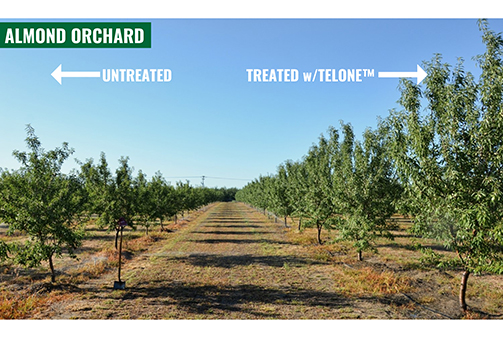Drip Irrigation Maintenance Pointers

Converting to microirrigation is a capital-intensive farming investment. Its main objective is to improve crop yield and production efficiency and save water along the way. Even the best microirrigation system requires regular inspection and preventive maintenance. Otherwise its advantages will be compromised.
For example, the slow buildup of deposits in emitters could cause the gradual degrading of emission uniformity (EU) and poor water and fertilizer distribution in the field. Though such disparities may not be visually evident early on, regular inspections of system pressure, flow rate, and filtration components could reveal their existence. If left unchecked, these issues could compromise system performance.
In many instances, poor system performance can be attributed to factors outside of the system itself, such as the fluctuation in the depth of groundwater in the supplying well or the changes in the chemical composition of irrigation water. Regular monitoring of system performance, including pump discharge rate, pressure, and water quality, will enable the system operator to anticipate rather than react to problems. This strategy keeps the system running smoothly and minimizes down time. It is important to remember that while preventive maintenance saves money, after the fact or reactive maintenance costs money.
Maintenance Program Outlines
Drip/microirrigation system maintenance aims at preserving EU and efficiency. This can be achieved by operating the system according to design pressures and flow rates while making regular field inspections, performing necessary preventive measures in a timely manner, and promptly remedying malfunctions.
This series of articles will cover three principal stages of maintenance (as mentioned below). This first article focuses on three factors of irrigation water analysis, while the next article will explain the various aspects of the analysis.
Stage 1. Prior To Irrigation System Installation. Before installing a drip system, it is important to evaluate water quality. A laboratory analysis of the source(s) of water needs to be done during the planning process. The information provided by this analysis may influence the choice of system components and its operation and maintenance.
Stage 2. Prior To Starting The First Irrigation Season. This stage includes two segments: filtration system adjustment and system evaluation. Adjust and then evaluate — in that order — before using the system. Adjusting the filtration system is vital to the performance of the filter and the drip/microirrigation system. In addition, evaluating the new system (or one that has been modified or repaired) is necessary because it provides the “as-built” system characteristics including emission uniformity. It also serves as a baseline for later evaluations.
Stage 3. System Inspection and Maintenance Routine. This stage focuses on maintenance functions performed when system operation begins. These functions are grouped into segments according to when they should be done: annually before the beginning of the irrigation season, during the season, and annually before shutting down the system.
To-Do List Before Installation
Preventive maintenance and monitoring should start before the system is installed. Information on quality of irrigation water sources should be made available to the system designer and irrigation manager so they can select suitable system components (e.g. filtration system) and devise an appropriate management and maintenance plan (e.g. chemical injection, flushing).
As mentioned previously, it is critical to obtain a laboratory analysis of the irrigation water before installing the system. This analysis needs to take into consideration three factors: the irrigation system, the soil, and agronomics.
Irrigation System Considerations
● Inorganic particles. Water to be used for drip/microirrigation should be carefully examined to assess possible clogging problems. The stream of water carries inorganic particles such as sand, silt, and clay, as well as organic particles like algae and weed seeds. These particles can block emitters, lateral lines, and filters. High loads of suspended particles in the irrigation water may require pre-filtration like settling ponds.
● Microorganisms. Bacteria carried with irrigation water can grow into a mass of slime. The slime may bind fine silt and clay particles in aggregates large enough to cause emitter clogging. Water rich in nitrate encourages microbial growth in the system. Microbial growth can be controlled by chlorine injection.
● Calcium carbonate precipitate. Bicarbonate is common in surface and groundwater. At a pH of 7.5 or higher and bicarbonate concentration of 2 milliequivalent per liter, the bicarbonate is as susceptible to precipitation as calcium carbonate (lime) if comparable levels of calcium are naturally present in the water or if compounds containing calcium are injected in the system. Calcium carbonate precipitate is the most common cause of chemical clogging. The usual treatment of lime precipitation is by acid injection in the system to lower the pH of the water below 7.0.
● Iron and manganese. Iron and manganese are often present in groundwater in soluble forms and they may precipitate out of the water due to changes in temperature or pressure, in response to a rise in pH or through the action of bacteria. The result is massive sludge or slime
capable of incapacitating the entire irrigation system. Iron and manganese could be separated from the irrigation water
by means of a settling pond or maintained in soluble forms by acid injec-
tion. Treatment choice depends on how cost-effective it will be for the grower.
● Oily water. The presence of oil in water will very rapidly block sand media and screen filters, clog emitters, and degrade other system components. Oily water should not be used for drip/microirrigation.
Soil Considerations
● Salinity and sodicity. The concentration and composition of dissolved salts in a water supply can affect soil properties, productivity of crops, and determine the suitability of water for irrigation. Because of the absence of deep percolation under drip/microirrigation, there will be practically no vertical leaching of salts unless the system capacity is large enough to supply the crop water requirements plus the leaching requirements.
On the other hand, water of low salt content applied to non-saline soils of low to moderate sodium adsorption ratio (SAR) can cause deterioration in soil infiltration rate. Mixing solution-grade gypsum into the irrigation water could maintain a favorable infiltration rate.
Continually using water rich in bicarbonate on the same field could result in developing sodic soils of restricted infiltration and poor crop vigor. Acid injection is advised with this water quality to maintain a lower pH. Irrigation water of high SAR could also lead to developing sodic soils. Applying solution-grade gypsum in the water is recommended to guard against developing soil sodicity.
Agronomic Considerations
● Specific ion effect. Boron is an essential element for plant growth in small amounts. However, a concentration slightly higher than the optimum requirements is toxic to plants. Plus, crops vary in their sensitivity to excess boron.
In addition to boron, chloride, which is toxic to some plants in high concentrations, is found in most natural waters. Excess nitrogen in irrigation water also may affect the production quality of crops.
Leaching, water mixing, crop rotation, and use of salt-tolerant crops may need to be considered if the quality of available irrigation water is less than favorable. The pH of water also affects the availability of various plant nutrients in the soil. Acid injection in the system may be necessary in some cases to control the pH of irrigation water.









